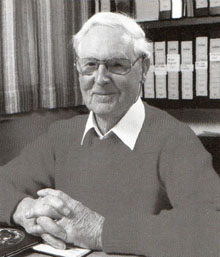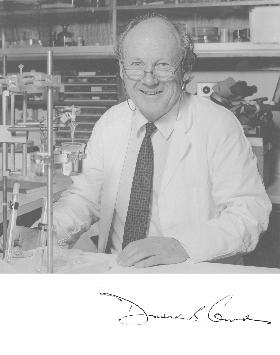Related Research Articles

Frank John Fenner was an Australian scientist with a distinguished career in the field of virology. His two greatest achievements are cited as overseeing the eradication of smallpox, and the attempted control of Australia's rabbit plague through the introduction of Myxoma virus.

Sir William Ian Clunies Ross was an Australian veterinary scientist. He has been described as the "architect" of Australia's scientific boom, for his stewardship of the Commonwealth Scientific and Industrial Research Organisation (CSIRO), the Australian scientific organisation.

John Shine is an Australian biochemist and molecular biologist. Shine and Lynn Dalgarno discovered a nucleotide sequence, called the Shine–Dalgarno sequence, necessary for the initiation of protein synthesis. He directed the Garvan Institute of Medical Research in Sydney from 1990 to 2011. From 2018 to 2022, Shine was President of the Australian Academy of Science.
Nancy Fannie Millis was an Australian microbiologist and Emeritus Professor who introduced fermentation technologies to Australia, and created the first applied microbiology course taught in an Australian university.

The Australian Academy of Science was founded in 1954 by a group of distinguished Australians, including Australian Fellows of the Royal Society of London. The first president was Sir Mark Oliphant. The academy is modelled after the Royal Society and operates under a Royal charter; as such, it is an independent body, but it has government endorsement. The Academy Secretariat is in Canberra, at the Shine Dome.
Suzanne Cory is an Australian molecular biologist. She has worked on the genetics of the immune system and cancer and has lobbied her country to invest in science. She is married to fellow scientist Jerry Adams, also a WEHI scientist, whom she met while studying for her PhD at the University of Cambridge, England.

Professor Kurt Lambeck AC, FRS, FAA, FRSN is Professor of Geophysics at the Australian National University in Canberra, Australia. He has also taught at University of Paris and at Smithsonian and Harvard Observatories.
The Pawsey Medal is awarded annually by the Australian Academy of Science to recognize outstanding research in the physics by an Australian scientist early in their career.
Fraser John Bergersen, was a New Zealand plant biologist.
William (Bill) Compston FAA, FRS is an Australian geophysicist. He is a visiting fellow at the Australian National University.
The Matthew Flinders Medal and Lecture of the Australian Academy of Science is awarded biennially to recognise exceptional research by Australian scientists in the physical sciences. Nominations can only be made by Academy Fellows.

Ian Frederick Allison AO AAM FAA is an internationally recognised Australian glaciologist and climate scientist. He was elected a Fellow of the Australian Academy of Science in 2016 in recognition of his work in understanding the role of "sea ice and Antarctica in the global climate system".
Frederick Colin Courtice FAA, was an Australian medical scientist who became an expert in lymphatic physiology.
Maxwell Frank Cooper Day was an Australian ecologist and the oldest living Fellow of the Australian Academy of Science. Born in Sydney, New South Wales, he turned 100 in December 2015. He is well known for his work on myxomatosis and the myxoma virus in the 1940s in conjunction with Professor Frank Fenner.

Sir Frederick William George White was a New Zealand-born Australian physicist and ornithologist who was Chairman of CSIRO from 1959 to 1970.
Arthur William Turner OBE FAA (1900–1989) was an Australian veterinary scientist and bacteriologist.

David Roderick Curtis AC MB BS PhD FRACP FAA FRS was an Australian pharmacologist and neurobiologist.
Alan Frederick Cowman AC, FRS, FAA, CorrFRSE, FAAHMS, FASP, FASM is an internationally acclaimed malaria researcher whose work specialises in researching the malaria-causing parasite, Plasmodium falciparum, and the molecular mechanisms it uses to evade host responses and antimalarial drugs. As of May 2024, he is the deputy directory and Laboratory Head of the Walter and Eliza Hall Institute of Medical Research (WEHI) in Melbourne, and his laboratory continues to work on understanding how Plasmodium falciparum, infects humans and causes disease. He was elected as a fellow of the Royal Society in 2011 and awarded the Companion of the Order of Australia in 2019 for his "eminent service to the biological sciences, notably to molecular parasitology, to medical research and scientific education, and as a mentor."
References
- ↑ "Professor John Sprent (1915-2010), parasitologist". Interviews with Australian scientists. Australian Academy of Science.
- ↑ John Frederick Adrian Sprent, DSc, CBE, FAA, www.science.org.au
- ↑ Sprent, John Frederick Adrian, FAA (1915-2010), trove.nla.gov.au
- ↑ Sprent, John Frederick Adrian (1915 - 2010), Australian Encyclopaedia of Science
- ↑ "The Order of the British Empire - Commander (Civil)". It's an Honour. 23 June 1984.
Education & science
- ↑ "Centenary Medal". It's an Honour. 1 January 2001.
For service to Australian society and science